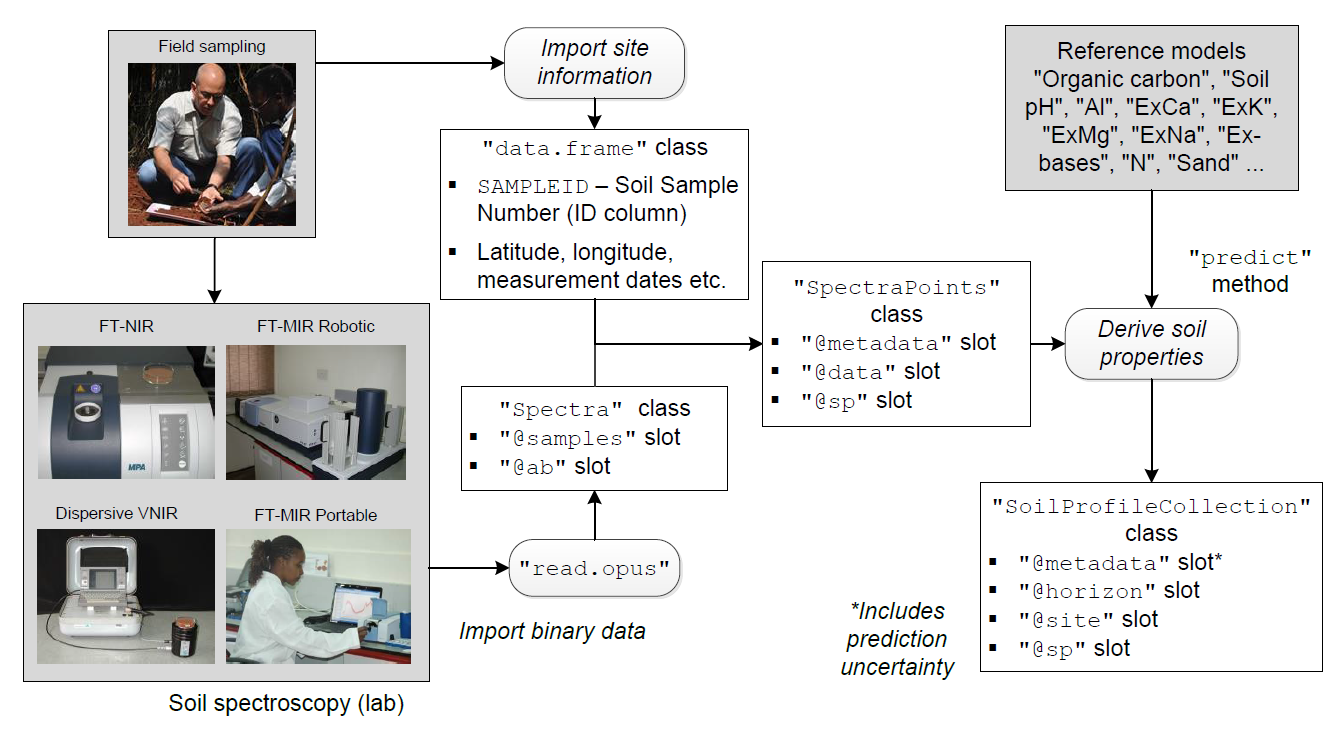
 |
Methods for soil spectroscopy and chemometrics involving spectral data conversion, calibration and prediction methods
No content added.
The project summary page you can find here. Description of the functions and data sets is available from the package documentation. To submit a bug report or a wish list please use the official package tracker.
soil.spec package: Soil spectroscopy tools and reference models
Table of contents:
A. (Andrew) Sila |
World Agroforestry Centre (ICRAF) Contact: A.SILA@CGIAR.ORG |
T. (Tom) Hengl |
ISRIC — World Soil Information Contact: TOM.HENGL@WUR.NL |

Fig: General processing workflow in soil.spec package
Among other things, the package provides:
Classes and methods for Spectra data (Spectra, SpectraPoints, and SpectraModel);
Generic fit.SpectraModel and predict.SpectraPoints methods based on the PLS models;
Reference models to predict soil properties (organic carbon, soil pH, Al, ExCa, ExK, ExMg, ExNa, Exbases, N, Sand) from spectral absorbance data (MIR, alpha-MIR and VISNIR);
Auxiliary functions to visualize Spectra objects and detect outliers;
To install from source please use:
> install.packages(c("pls", "KernSmooth", "wavelets", "hexView", "sp", "GSIF", "e1071", "class", "chemometrics", "plyr", "plotKML", "mgcv", "nlme", "spatstat", "scales", "date", "lava"))
> install.packages("soil.spec", repos=c("http://R-Forge.R-project.org"), type = "source")
Typical workflow in the soil.spec package is:
> #1. Import binary file containing absorbances (OPUS):
> xx <- read.opus("icr_087266_B2.0")
Creating object of type "SpectraPoints"...
> #2. Load the reference model:
> data(m.PHIHOX)
> #3. Predict soil pH based on the reference model:
> s.xx <- predict(xx, model = m.PHIHOX, prob. = .75)
> s.xx
PHIHOX PHIHOX_lower PHIHOX_upper
icr087266 9.1 8.58 9.62
This package has been build to read OPUS files from the three Bruker spectrometers into R to be used in chemometric methods e.g. developing calibration models, for prediction, clustering, etc. CO2 bands (2380-2351 cm-1) within the MIR data are removed at the time of conversion from the original OPUS format, to ensure consistent spectra obtain from different parts of the world with varying CO2 concentration in the atmosphere.
OPUS (OPtical User Software) is the Bruker data collection and analysis program for Alpha, Multi-Purpose Analyzer (MPA) and Tensor 27 FT-IR (HTS-xt) spectrometers. Spectral data files stored in this format are characterized by a numeric extension, usually a zero unless there are duplicates which are given increamented by one. There are lots of spectral details stored in form of data-blocks inside these files ranging from date and time of measurement, type of instrument used, Absorbance values, IR regions and much, please visit this link for details.
soil.spec package provides reference models to predict a list of targeted soil properties (organic carbon, soil pH, Al, ExCa, ExK, ExMg, ExNa, Exbases, N, Sand) directly from absorbances, i.e. without a need to fit your own calibration data. How were these models fitted? We used the calibration data (1391 samples) from the Africa Soil Information Services (AfSIS) project to fit pan-African soil spectroscopy calibration models (note: these models will be continuously updated as the new calibration data arrives). To learn more about the AfSIS project, please visit this link.
Correlation plots:*Note: ExNa is difficult to predict and is good to show this from the models. Al prediction are poor for low values <150 mg/kg as can be seen from the HTS-xt MIR models, though MPA model is not as good as the other two.
While every effort has been made to ensure that the data distributed by ICRAF / ISRIC are accurate and reliable, ICRAF / ISRIC assumes no responsibility for any error or omission in the datasets nor for any direct, indirect or consequential damages arising from the use of the Datasets. ICRAF / ISRIC reserve the right to modify any information in these webpages and related datasets without notice.
If not specified otherwise, all data and software products derived from the AfSIS project (Africa Soil Information Service; funded by the Bill and Melinda Gates foundation) are released under the Creative Commons Attribution license.
Note: conversion from spectral absorbances to soil properties can be of variable accuracy and can often lead to imprecise soil data (see confidence limits). We advise users of these tools to regularly collect calibration data and then send validation results to the package authors for quality control. Also note that the reference models used in the soil.spec package will be continuously updated as the new calibration data arrives, so when reporting bugs or incosistencies, please refer to the package version.
Correct citation:
Sila, A. and Hengl T. 2014. soil.spec package: Soil spectroscopy tools and reference models. R package version 2.1.4, URL http://CRAN.R-project.org/package=soil.spec.
The AfSIS project has been funded by the Bill and Melinda Gates foundation and the Alliance for a Green Revolution in Africa (AGRA). To learn more about the AfSIS project, visit the project website at Africasoils.net and/or the AGRA website.
| Last update: July 4, 2014 | World Agroforestry Centre (ICRAF) |